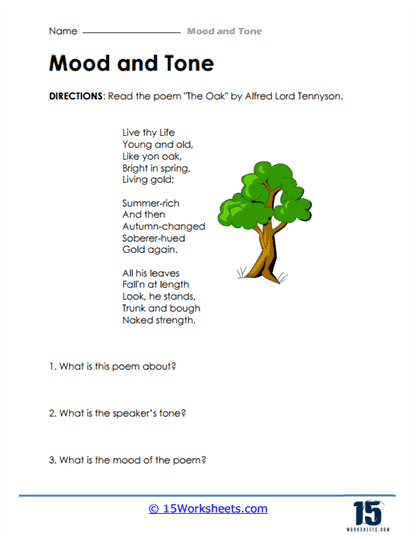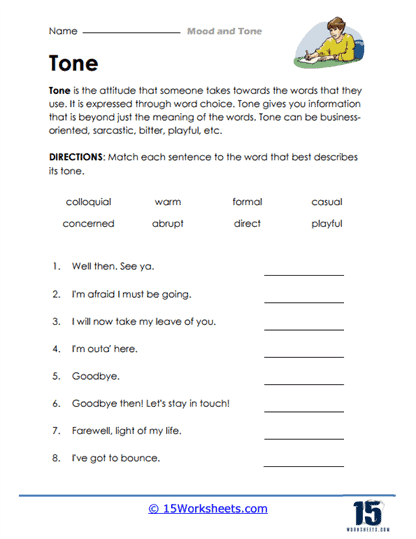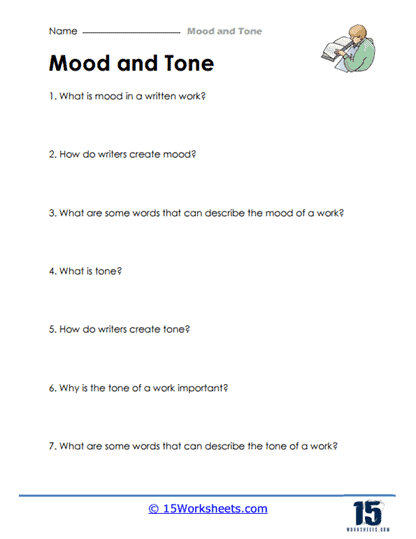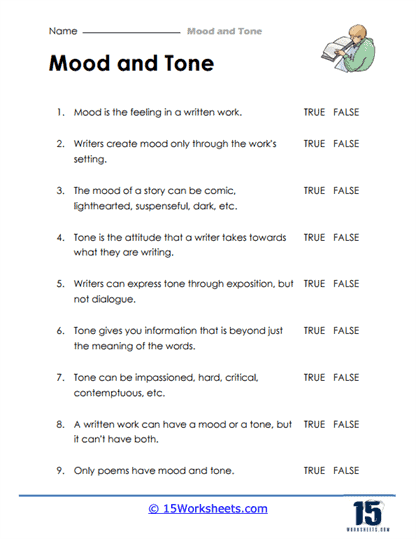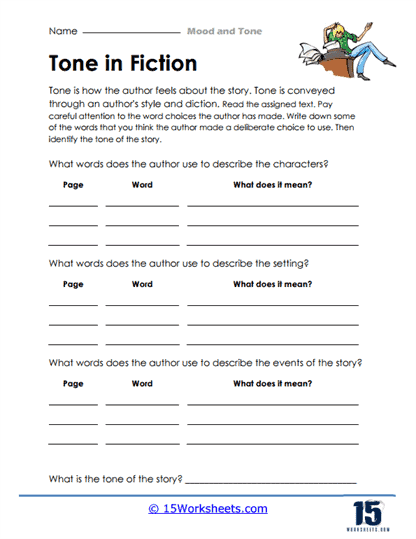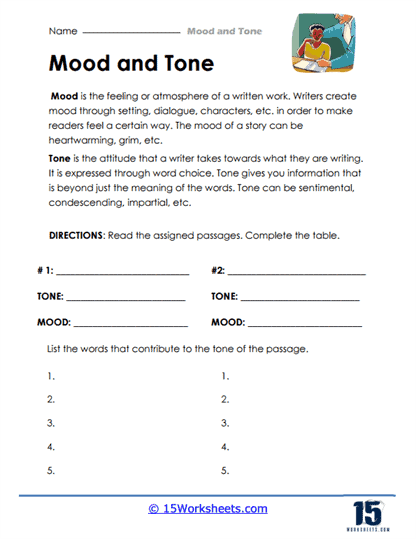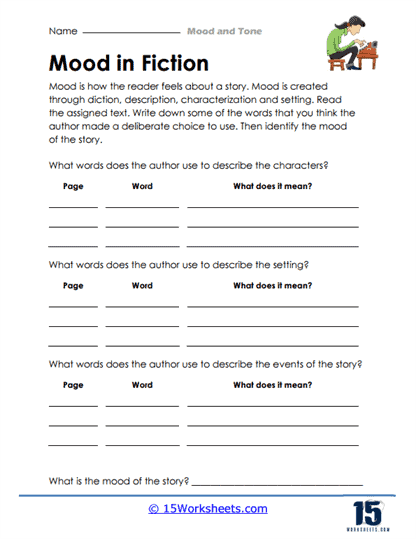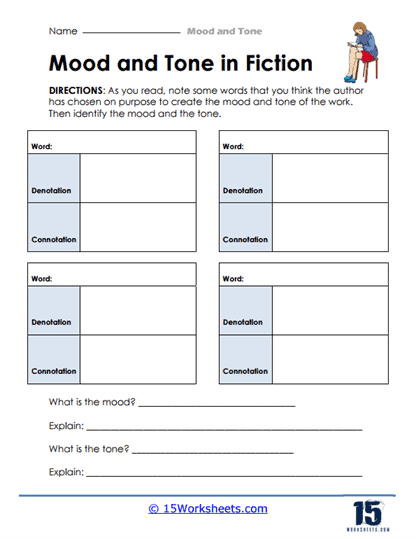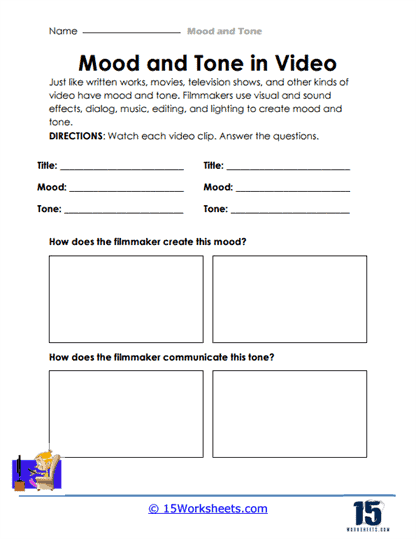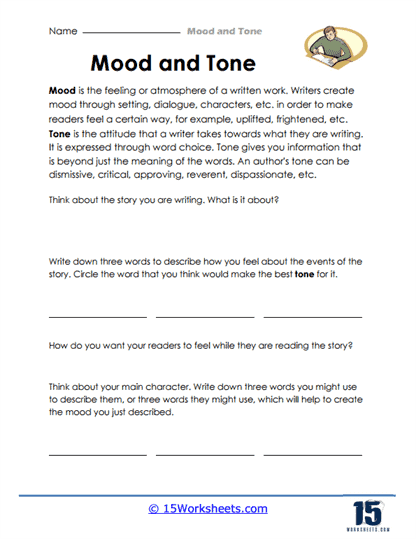Mood and Tone Worksheets
All About These 15 Worksheets
Mood and tone are elements of literary analysis that contribute to the overall atmosphere and emotional impact of a piece of writing. These worksheets typically include exercises and activities that encourage students to identify, analyze, and discuss the mood and tone in various literary works.
The worksheets involve the following activities:
Mood Identification – Students are given excerpts or passages from literary texts, and they need to identify and describe the mood or atmosphere conveyed by the writing. This activity helps students develop their ability to recognize the emotional and atmospheric qualities of a text.
Tone Analysis – Students are provided with examples of text and they have to identify the tone or attitude of the writer. They may need to analyze the writer’s choice of words, language style, and overall writing style to determine the tone. This activity helps students understand how the writer’s tone can shape the reader’s perception of the text.
Comparing Mood and Tone – Students are given different excerpts or passages and they have to compare the mood and tone between them. They may need to identify similarities or differences in the emotional qualities and attitudes conveyed in the texts. This activity encourages students to analyze and interpret the author’s choices in creating mood and tone.
Writing Exercises – Students are asked to write their own paragraphs or short stories with a specific mood or tone. This activity allows students to practice using descriptive language, word choice, and stylistic devices to effectively convey a desired mood or tone in their writing.
Discussion Questions – Students engage in class discussions or group activities to analyze and interpret the mood and tone of selected literary texts. They may be asked to support their interpretations with evidence from the text and engage in critical thinking about the author’s intentions and impact on the reader.
What is Mood and Tone in Literature?
Mood and tone are elements of literature that contribute to the overall atmosphere, emotional impact, and author’s attitude in a literary work. These examples demonstrate how mood and tone in literature contribute to the emotional and atmospheric qualities of a work and shape the reader’s interpretation and experience. The choice of words, descriptions, and overall writing style play a significant role in establishing the mood and conveying the author’s attitude or tone.
Examples of Mood
Mysterious Mood – “The moon shone brightly through the dense mist as the protagonist ventured deeper into the ancient forest, his heart racing with anticipation. Every crackle of a twig and hoot of an owl heightened the eerie sense of mystery and foreboding that permeated the night.”
Joyful Mood – “The sun bathed the golden meadow in a warm glow, casting vibrant hues of orange and pink across the horizon. Children laughed and frolicked, their carefree spirits lifted by the joyful ambiance of the summer day. The scent of blooming flowers and the melodious chirping of birds filled the air with happiness and serenity.”
Melancholic Mood – “Raindrops trickled down the windowpane, mirroring the tears that silently streamed down the protagonist’s face. The gray sky matched the heaviness in their heart as they mourned the loss of a loved one. Each somber note of the piano resonated with the bittersweet memories that lingered, enveloping the room in a melancholic embrace.”
Examples of Tone
Playful Tone – “The mischievous cat leaped from the windowsill, landing with a soft thud before prancing across the room. With a twinkle in its eyes and a flick of its tail, it taunted the dogs, teasing them with its nimble movements and impish charm. The author’s playful tone was evident as they painted a lively and amusing picture of the cat’s antics.”
Solemn Tone – “The author’s voice resonated with a solemn tone as they described the aftermath of the devastating war. The stark descriptions of destroyed homes, grieving families, and shattered lives conveyed a sense of loss and despair. Through their somber words, the author evoked a deep sense of reflection and empathy in the reader.”
Satirical Tone – “With biting wit and sharp observations, the author employed a satirical tone to critique the absurdities of society. Their exaggerated portrayals of pompous politicians and materialistic individuals served as a scathing commentary on the values and priorities of the time. Through clever wordplay and irony, the author aimed to provoke laughter while highlighting underlying societal issues.”





